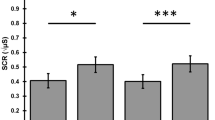Summary
Brain potentials evoked by unexpected stimuli show a late wave-complex with peak latencies of 250–350 msec and relative large amplitudes (maximal 15–30 μV). This “orienting potential” is especially prominent in cases in which a motor reaction to the unexpected stimulus has to be performed. But it may be seen in some control cases without any overt movement.
Orienting potentials are evoked as well by unexpected changes of the occurrence of stimuli in time as by unexpected changes of sense modalities. If the deviation of the time-model of the stimuli is larger, the amplitude of the orienting potential is larger too.
If a reaction has to be performed to the next regular stimulus, following the unexpected stimulus, longer lasting readiness- and expectancy potentials between the two stimuli can be evoked. Even in such cases one may see an orienting potential, following the unexpected stimulus. The slowly rising negative readiness- and expectancy potentials start in such an experimental design to become positive not at the moment of motor reaction, but much earlier at the “decision point”.
Zusammenfassung
-
1.
Hirnpotentiale bei unerwarteten Signalen zeigen das Auftreten eines späten Wellenkomplexes mit Spitzenlatenzen von 250—350 msec und relativ großen Amplituden (maximal 15—30 μV). Dieser als „Orientierungspotential” aufgefaßte Wellenkomplex ist besonders verstärkt, wenn auf das unerwartete Signal reagiert werden muß, er kann aber auch ganz ohne motorische Reaktion auftreten.
-
2.
Orientierungspotentiale können sowohl bei zeitlicher Verschiebung des Erwartungszeitpunktes, als auch bei Fehlerwartungen hinsichtlich der Sinnesmodalität beobachtet werden.
-
3.
Wenn die Abweichung vom Zeitmodell der Reize größer ist, so ist die Amplitude des Orientierungspotentials ebenfalls größer.
-
4.
Durch Reaktion auf den nächsten regulären Reiz, der dem Zwischenreiz folgt, konnten längerdauernde Bereitschafts- und Erwartungspotentiale ausgelöst werden. Auch hier konnte vorher ein Wellenkomplex, welcher dem Orientierungspotential entspricht, abgegrenzt werden.
-
5.
Die Positivierung der langsam ansteigenden negativen Bereitschafts- und Erwartungspotentiale beginnt in dieser Anordnung deutlich vor der motorischen Reaktion, also zum Entscheidungszeitpunkt.
Similar content being viewed by others
Literatur
Bancaud, J., V. Bloch et J. Paillard: Contribution EEG à l'étude des potentiels évoqués chez l'homme au niveau vertex. Rev. neurol. 89, 399–418 (1953).
Gaspers, H.: Changes of cortical D.C. potentials in the sleepwakefulness cycle. In: The nature of sleep. London: Churchill 1961.
Ciganek, L.: A comparative study of visual and auditory EEG responses in man. Electroenceph. clin. Neurophysiol. 18, 625–629 (1965).
Gastaut, Y.: Les pointes négatives évoquées sur le vertex. Leur signification psychophysiologique et pathologique. Rev. neurol. 89, 382–399 (1953).
Gilden, K., H.G. Vaughan and L.D. Costa: Summated human EEG-potentials with voluntary movement. Electroenceph. clin. Neurophysiol. 20, 433–438 (1966).
Haider, M., P. Spong and D.B. Lindsley: Attention, vigilance and cortical evoked-potentials in humans. Science 145, 180–182 (1964).
Haider, M.: Kongreßbericht des VI. Int. Kongresses für EEG und klinische Neurophysiologie, Wien 1965.
Kornhuber, H.A., L. Deecke: Hirnpotentialänderungen bei Willkürbewegungen und passiven Bewegungen des Menschen. Bereitschaftspotential und reafferente Potentiale. Pflügers Arch. ges. Physiol. 284, 1–17 (1965).
Rowland, V., and M. Goldstone: Appetitively conditioned and drive-related bioelectric baseline shift in cat cortex. Electroenceph. clin. Neurophysiol. 15, 474–478 (1963).
Shvets, T.B.: Conference on electrophysiology of higher nervous activity. Abstracts, Moskau 1958.
Sokolov, Ye. N.: Perception and the conditioned reflex. Oxford: Pergamon Press 1963.
Spong, P., M. Haider and D.B. Lindsley: Selective attentiveness and cortical evoked responses to visual and auditory stimuli. Science 148, 395–397 (1965).
Sutton, S., P. Tueting, J. Zubin and E.R. John: Information delivery and the sensory evoked potential. Science 155, 1436–1439 (1967).
Walter, W.G., R. Cooper, V.J. Aldridge, W.C. McCallum and A.L. Winter: Contingent negative variation: an electric sign of sensorimotor association and expectancy in the human brain. Nature (Lond.) 203, 380–384 (1964).
Weitzman, E.D., and H. Kremen: Auditory evoked responses during different stages of sleep in man. Electroenceph. clin. Neurophysiol. 18, 65–70 (1965).
Williams, H.L., D.I. Tepas and H.C. Morlock: Evoked responses to Clicks and electroencephalographic stages of sleep in man. Science 138, 685–686 (1962).
Author information
Authors and Affiliations
Additional information
Mit finanzieller Unterstützung durch den Österreichischen Forschungsrat und NIH Grant TW 00156-03.
Rights and permissions
About this article
Cite this article
Haider, M., Groll, E. & Studynka, G. Orientierungs- und bereitschaftspotentiale bei unerwarteten reizen. Exp Brain Res 5, 45–54 (1968). https://doi.org/10.1007/BF00239904
Received:
Issue Date:
DOI: https://doi.org/10.1007/BF00239904




